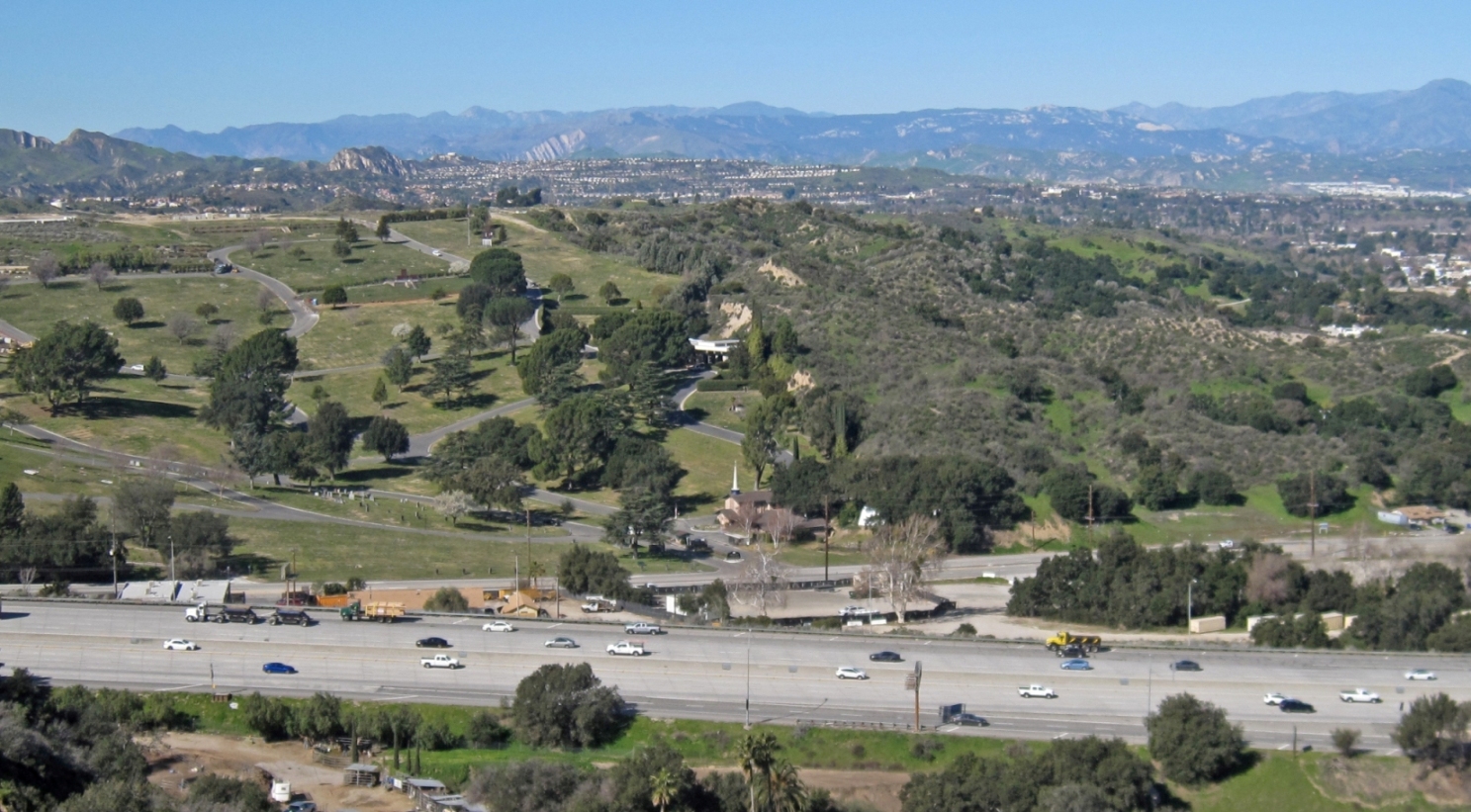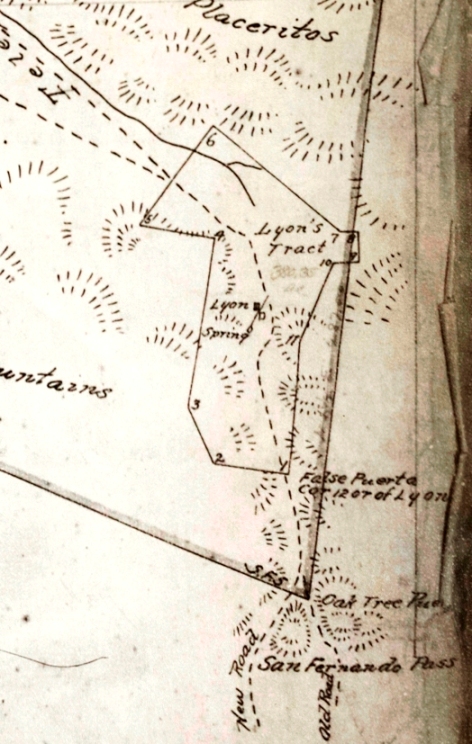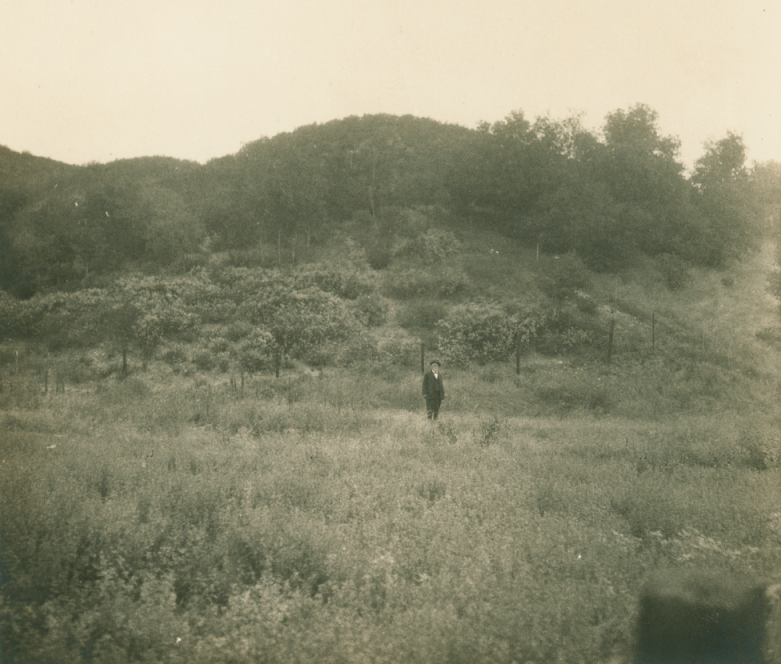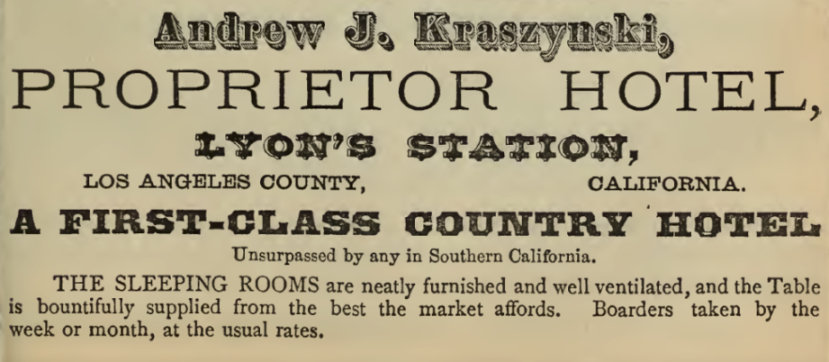

"The stage station was probably started by Cyrus Lyons and Sanford Lyons, brothers, in 1855, when the stage line was established to San Francisco. They were operating it in 1856, for at that date Harris Newmark tells the story of one of the brothers..."Perkins' source is Harris Newmark's book "Sixty Years in Southern California".(2) Published in 1916, Newmark (1834-1916) called this book his reminiscences. As far as I know, he had kept no diary or journal during his lifetime. He relied only on memory. At the age of 79 (in 1913 when he wrote the book) he was recalling incidents in his life roughly in chronological order. With the station, those incidents had happened almost 60 years previously. Sanford and Cyrus Lyon were long dead and could not be consulted. "Sixty Years" was not meant to be a formal history book. The dates have to be questioned without other supporting documents.
"About the time the [California] Rangers [organized in 1853] were starting on their crusade, Henry Clay Wiley bought a piece of land from [Don Ygnacio] Del Valle, setting up a stage stop and installing a windlass on top of Fremont Pass to lower wagons down the precipitous cliffs. In September 1855, the Lyon brothers bought the place, making some improvements. Aside from the depot, there was a store, post office, saloon, a large barn and a cottage tucked away in the stately oaks. It was a stop on the famed Butterfield Overland Stage before the Civil War broke up the Ox-Bow Route."..."Realizing that the railroad would soon bypass them, Sanford and Cyrus Lyon sold the station to a fellow name Hart in 1875."..."Lyon Station went through several owners and was used as a backdrop for a couple of early western films before it burned to the ground in 1919."Wow. No wonder Reynolds called these articles (and he wrote many) "Tales" because, at least for Lyon's Station, this was almost all pure fiction. Although many documents report that a windlass was used to help get wagons over Fremont Pass, none give any credit to Wiley, probably because he wasn't there at the time. Wiley's windlass was invented by Reynolds. He also made up the sale date of September 1855. No early movies are known to have been filmed there and no contempory source says that it "burned to the ground in 1919 (although some more contempory sources do say 1919)." Unlike Perkins, Reynolds, as usual, provided no sources.
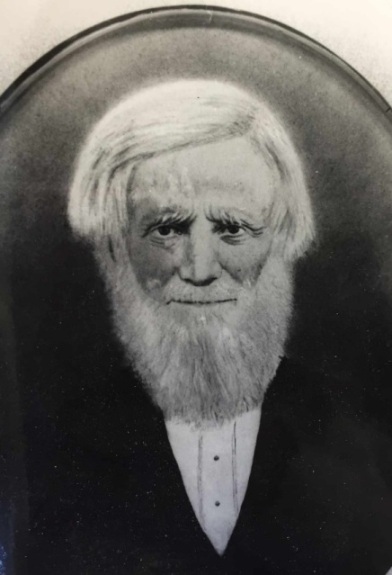
"I took a trip to the Tejon the other day, with Banning. We started at 4 A.M. and the fog enveloped us till we passed San Fernando. We lowered ourselves down the mountains, somewhat more carefully than Banning's usual custom. We took the horses out, and led them down; while the wheels of the carriage were locked, and Buchanan, and Mac and I, eased it down. Half a mile from the [Fremont] Pass, we came to old Hart's place [Josiah would have been 64 years old]. He came out with a smile, and shook his white locks like a grizzly, as we unharnessed, preparatory to a hasty lunch, There was a large amount of stock in his corrals en route for the north - cows and calves mostly, and the finest to be found in this county; emigrants, also, and freight teams. In fact, there seemed to be a general gathering of moveable property, and, like ourselves, they were obliged to stop at old Hart's, because the next water is distant fifteen miles. The house scarcely deserves the name - it is only a stopping place. But one gets deceived if he expects to get any good drink there. The whiskey and brandy anywhere else would be warranted to kill at sight, and this was the only show we had for quenching thirst. We didn't wait long, but pushed on over the sandy plains of the Rancho de San Francisco, ten miles to the mouth of the San Francisco [San Francisquito] Pass, where we found a relay of horses."The newly created Butterfield Overland Mail Company published its routes and distances in the Los Angeles Star of August 28, 1858. "Hart's" as a stop, was there.
"The road [from San Fernando Mission] lead through the New Pass [the San Fernando Pass], where it strikes the old road from San Bernardino to the Tejon Pass of the Sierra Nevada mountains. The canyon road is rugged and difficult. About the centre of the pass is, I believe, the steepest hill [San Fernando hill] on the whole route. I should judge it to be full 800 feet from the level of the road, which has to be ascended and descended in the space of a quarter of a mile. Perhaps my idea of the distance is not correct; but certainly it is a very steep hill, and out six horses found great difficulty in drawing out empty wagon up. The road takes some pretty sharp turns in the canyon, and a slight accident might precipitate a wagon load into a very uncomfortable abyss. At the base of the canyon is the smooth sandy bed of a creek, which is dry. Eight miles from San Fernando we changed horses again, at Hart's ranch, having made nearly ten miles per hour, and in spite of the bad condition of the roads, after one of the heaviest rains ever known in the country."Besides what Ormsby said, the stage coach distance between Hart's and San Fernando (at the mission) was also reported as 8 miles in numerous newspapers in the late 1850's and early 1860's.(17) For example, the New York Herald of November 19, 1858, reports "Eight miles from San Fernando we changed horses again at Hart's ranch."
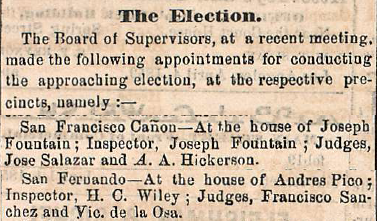
Commencing at an oak tree marked P with a cross, situated on the high road that goes from San Fernando to Fort Tejon upon the northern side of the "Cuesta de San Fernando" at a place called the "Puerta"; Thence running N 6 1/2 E one hundred and sixty chains; Thence N 77 W one hundred and sixty chains; Thence S 6 1/2 W one hundred and sixty chains; Thence S 77 E one hundred and sixty chains to point of commencement.Fountain answered the complaint by saying that he had been on the ranch for 5 years and had made $5000 worth of improvements. However, on January 3, 1861, he withdrew his answer. The judge then ruled in favor of the Plaintiffs.
"We spent the night here [The San Fernando Mission], and the next morning crossed over to the Overland Mail Company's way station. The Company has done a large amount of work on the road; they [E.F. Beales' team of men - working for Beale not the Overland Company] have cut through one hill a distance of nearly 150 feet long and 50 feet high. I was not prepared to find so much labor expended on a single enterprise."The Los Angeles Star of August 22, 1863, still called it "the old Fountain house," even though he had been gone for nearly two years.
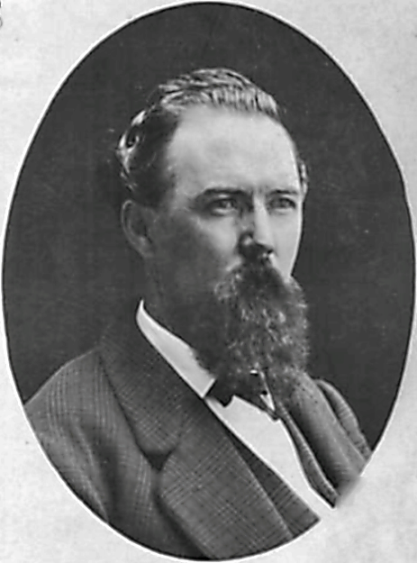
"We arrived at Mr. Wiley's at 11 o'clock A.M. After an hour's resting and taking a little of the substantial for the inner man, we again proceeded in company with Mr. Wiley who kindly showed us the oil wonders and the beautiful country containing the finest springs of oil we ever saw, and perhaps the richest upon this coast." Letter to editor from Vincent Gelcich.On March 17, 1866, the Wilmington Journal published the distances from Wilmington to Owens River: "...Los Angeles to Cahuenga Pass 9; Cahuenga Pass to San Fernando Mission 12, San Fernando Mission to Wiley's 7; Wiley's to McCullock Station 14; McCulloch Station to Major Gordon 10;..." In the Wilmington Journal of May 5, 1866 we get a little description:
"Wiley's is situated in the midst of a little grove, which is reached after paying toll and passing through a deep gorge cut in the mountain by the enterprising turnpike company. At this station excellent water can be obtained, and it is abundant as far as Major Gordon's, which is about fifty miles from Los Angeles."The Los Angeles Semi-Weekly Southern News of June 6, 1866, thought that an oil refinery was needed near Wiley’s:
The necessity of a refinery in the immediate locality is daily more apparent. Wiley's ranch on the road, 2 miles from the toll gate, appears to be the most desirable position; it is central, with an abundance of wood and water."In his July 3, 1866, letter to E.F. Beale, Christopher Leaming also suggests an oil refinery near Wiley's house:(33)
"The largest work going on is upon the Wiley Springs. The company are running five tunnels and one well, they are getting about six barrels per day of oil that is fair quality, with an increase daily. They have on hand 250 barrels of oil, and are now making arrangements for a refinery to be put up at Mr. Wiley’s House on the Tejon Road."A refinery would be built there, but in 1874, six years after Wiley was gone.
"We, the undersigned, do hereby declare our intention to apply to the Board of Supervisors of Los Angeles county, State of California, on Saturday, the 13th day of June, A.D. 1868, or at the first meeting of said Board thereafter held, if none shall be held on that day, for authority to construct a wagon road from a Ranch known as Wiley's Ranch, in the said county of Los Angeles, thence along the Santa Clara Valley to the Soledad canyon, and through said canyon to the summit of the mountain; the said entire road being located in the said county of Los Angeles..."I don't know whether that road was built or not.
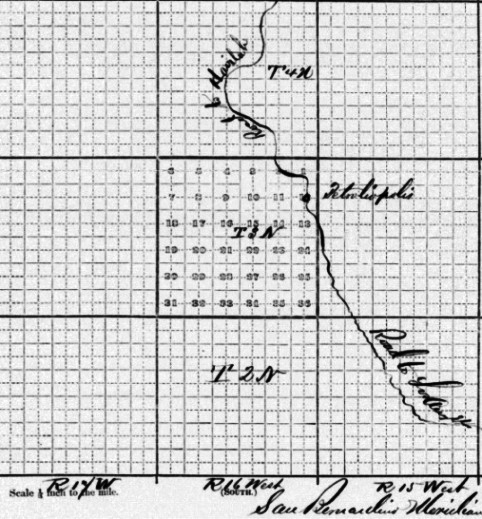
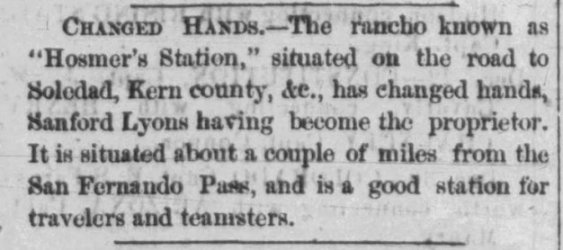
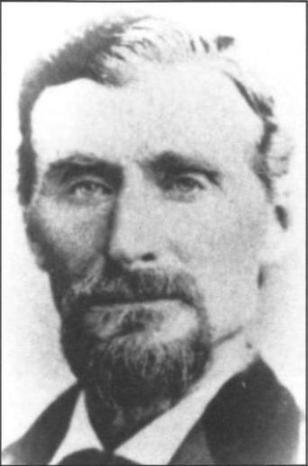

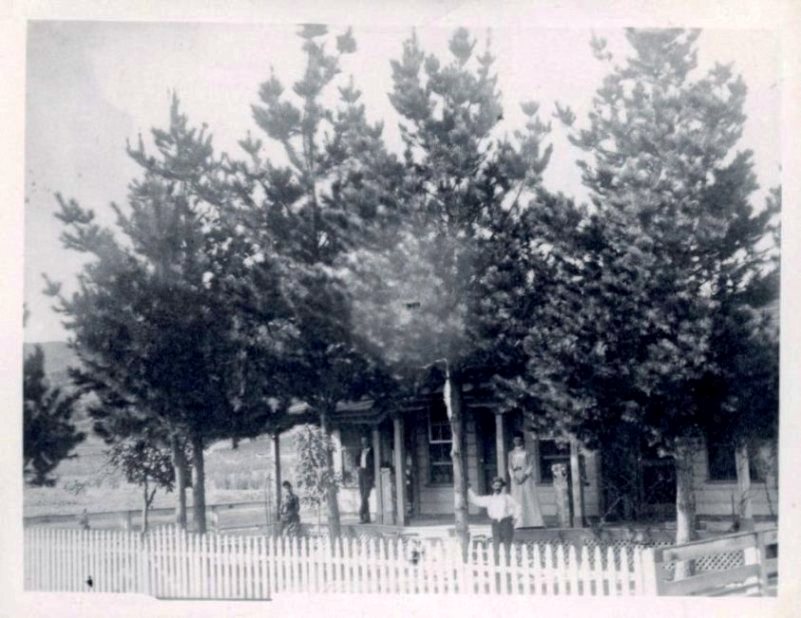

"Beginning at the San Fernando Station, the present terminus of the Southern Pacific Railroad, the line can be laid through the canyon now occupied by Telegraph Stage Road, thence by short tunnel through the summit, via Lyon's Station, until we reach the head-waters of the Santa Clara river..." "The physical difficulties which are met with upon this route are at first quite formidable. The passage at the San Fernando mountain, which occurs immediately after leaving the railroad station, will necessitate either the use of exceedingly steep gradients or the expenditure of a large sum in a tunnel and approaches. From the railroad station north a vertical rise of seven hundred and fifty feet has to be overcome in five and a half miles, a portion of which distance cannot be made available on account of the formation of the ground, while in descending north towards Lyons Station we encounter within a mile and a half a fall of four hundred and thirty feet. If we use a gradient of one hundred and twenty-five feet per mile upon the southern and one hundred feet upon the northern slope of this pass, it is estimated that an expenditure of at least $110,000 would be required to grade the first ten miles after leaving the railroad station."Unfortunately for Lyon's Station, that route would not be chosen.
"We soon arrive at Lyon Station, which is quite a resort for tourists and is a beautiful place, surrounded by groves of oak and sycamore trees, and which is destined to become a place of no little importance. There is a store and telegraph office here, besides the hotel and the oil refinery, which at present is not refining any oil, the new process having done away with the old method."Ventura Signal, August 15, 1874:
"We soon drove on and quickly found ourselves at Lyon's station, a charmingly located place, at which there is a postoffice, telegraph office and hotel all in one. Here are also extensive oil works, and gold mines up the canyon. Great teams with their little chimes of musical bells; the daily stages with their four horses and dashing drivers are constantly passing this place making it a lively one. Here were men from all parts of the United States and all nationalities, representing mining interests, etc. From here I took Sam Harper's stage for Soledad, and this ride of twenty-eight miles was through the wildest and most picturesque scenery of our route [which was from Ventura to Soledad]."Los Angeles Evening Express, September 8, 1874:
"Within a radius of ten miles around Lyon Station there is probably more variety of minerals than in any equal area in the country. Hundreds of oil springs, a rich gold region, and mines of asbestos, antimony, and specimens of quicksilver, coal, lead, iron and many other minerals, have been found in the mountains in the vicinity of this place."From the Los Angeles Herald of Sunday, March 18, 1875, comes this physical description of the station:
"Though unpretentious in itself, it is an inviting place for the weary denizen of the city, where he can play the recluse if he wish, breathe the invigoration mountain air and banish all thought of care and responsibility. The station proper is a well constructed frame building about 30x60 feet in dimensions and answering at once the purposes of a store, Postoffice, telegraph office, depot and tavern, being, altogether, the head centre of the adjacent valley. Besides this there is a large stable, and, back towards the foot-hills on the West, a little cottage half hid by a heavy growth of mountain oak. This makes up the sum total of Lyon's Station. Upon our arrival we found our old friend Captain Kraszynski in charge, who was doing the honors of mine host in the absence of his brother, the proprietor of the establishment. The Captain is one of those whole-souled men who never does things by halves in the matter of hospitality, and we have to thank him for the thousand kindly attentions which we experienced while under his roof-tree and which made our stay so pleasant."By this time it was apparent to the Kraszynskis that the proposed railroad would not pass by Lyon's Station. Andrew decided to move closer to the railroad. He leased some land on Rancho San Francisco from Jose M. Soto, owner of 1/4 interest in the Rancho (with the other 3/4 owned by Henry M. Newhall). The new station would be a little over a mile northwest of Lyon's Station and near the intersection of today's Newhall Ave. and Pine Street at the mouth of Railroad Canyon. This was close to the route of the new railroad, which would be through Railroad Canyon. Construction of the station started by June of 1875. The Los Angeles Herald of June 9, 1875, reported that "The Kraszynski brothers are building a fine house about a quarter of a mile [bad estimate by them] above their present locaton at Lyon's Station. It will have seventeen rooms, besides the store-rooms, and when finished there will be a lively house-warming, in about two weeks, to which the proprietors invite their friends."(65)
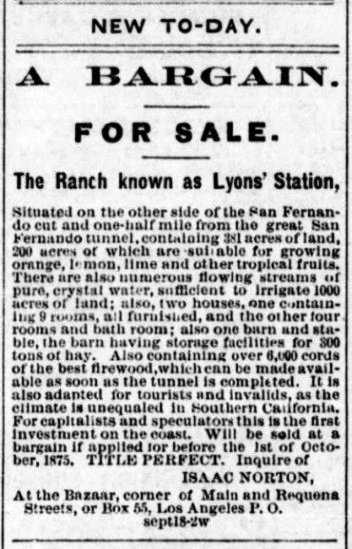
"For the first time I tried the trip to San Francisco by stage and cars via Caliente and Lyon's Station. From Ventura to Lyon's the distance is about sixty miles, the road a good one, and the stage, through drawn by two pretty good horses, is in my opinion rather a one-horse affair. At Lyon's Station I had to lay over from 9 o'clock in the evening till next morning at 6 o'clock. After trying in vain to partake of the miserable supper spread before me, I gave it up and retired to a bed in keeping with the table. At 6 o'clock the stage from Los Angeles arrived, which was to convey us to the present railway terminus, Caliente."A robbery near the station was reported by the Santa Barbara Daily Press of December 21, 1875: "The Telegraph stage bound up was robbed this morning, near Lyon's Station, thirty-two miles from this city [Los Angeles]. Nothing was taken but the express box. The agent in this city informs us that the box contained no treasure or anything of value, and that the robbers were hugely swindled."
"Malezewski, who committed suicide at Lyon's Station yesterday, was a monomaniac on the subject of his debts. He owned $2000 to the bank of Temple & Workman, and had an idea that the assignees would at once foreclose on him. Hence the rash act. Don David W. Alexander did his utmost to disabuse him of this idea, but ineffectually. He was really in comfortable circumstances."As it would turn out, Alexander was wrong about Malezewski's finances.
"Yesterday morning Adam Malezewski, of Lyon's Station, committed suicide by taking poison, at that place. Mr. Malezewski had resided in Los Angeles county for the last twenty-five years. He left all his property, which amounts to nearly fifteen thousand dollars, to Don David Alexander, the Sheriff elect of Los Angeles county. He had once been an employee of Mr. Alexander's for twelve years."
"The tract of land was appraised at $25,000, but petitioner does not believe it will bring anything like that sum if sold either at public or private sale, nor indeed enough to pay the debts of said estate. Said land had a few small houses [although a 9-room and 4-room house should have been substantial] and a little fencing on it, which are of but little value and otherwise it is uninproved. The land with the improvements rent for fifty dollars a month."..."The personal estate in the hands of your petitioner is insufficient to pay the debts outstanding against the deceased and the debts, expenses, and charges of the adminstration, and that it is necessary to sell the whole of the real estate for such purposes."Another appraisal of the real estate was done and this time the ranch was valued at only $8,000. Total debts were shown to be about $7990 (6554 for creditors + $1436 for administration expenses). On November 8, 1877, the judge finally ordered the sale of the entire ranch within one year.(70)
|
|
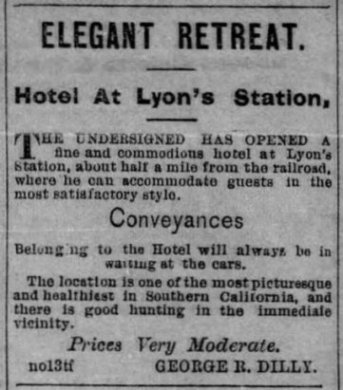
|
|
Henry M. Newhall from SCVHistory website. |
Los Angeles Evening Express, June 19, 1879. |
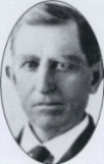 |
| ca. 1900 |
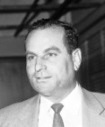 |
| 1955 |
 |
| ca. 1949 |
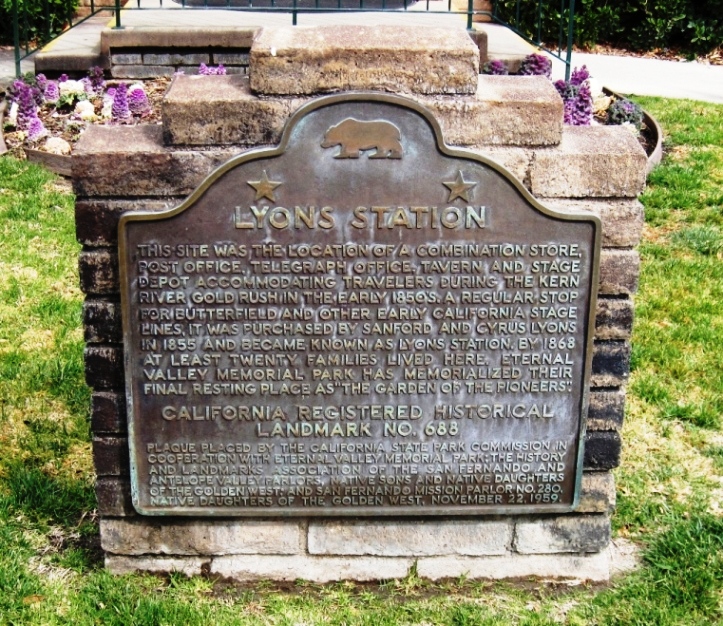

"In a lower corner of the cemetary, visible from the highway, is a group of burial enclosures. One of these is unmarked, but an adjoining one holds the last resting place of W.G. Thibaudeau, who passed awy in 1913. Nearby in a wooden enclosure is the grave of Chesley W. King, who passed away in 1904 at the age of 23 years. Close by is still another unmarked wooden enclosure and back of it a modern granite headstone for John Stahl, who died in 1911. Passing by this group of graves, a number of mounds may be seen on the floor of the draw - some of them just mounds, others distinguished by a big granite boulder for a headstone, and perhaps a circle of small stones around an unmarked mound."Today, there are no unmarked graves in the Garden of Pioneers. I wonder what happened to the old ones when Eternal Valley Memorial Park was built?
"J.H. Whitney, for whom Whitney Canyon was named, buried his three children in the cemetery one by one as they fell victim to the dread diphtheria plague. Willie, the first child of this early day homesteader and his wife, died just before his sixth birthday in 1881...then followed the tragic deaths of their daughters, Nettie at eight in 1884 and Mable 10, in 1888."Nettie and Mable both actually died in 1888 (indicated on their gravestones in an old photo seen here from the SCVHistory website). All three children had gravestones. However, only Mable's headstone exists today. Evidently, the bones of Willie and Nettie were combined with Mabel's and the their headstones were discarded.
